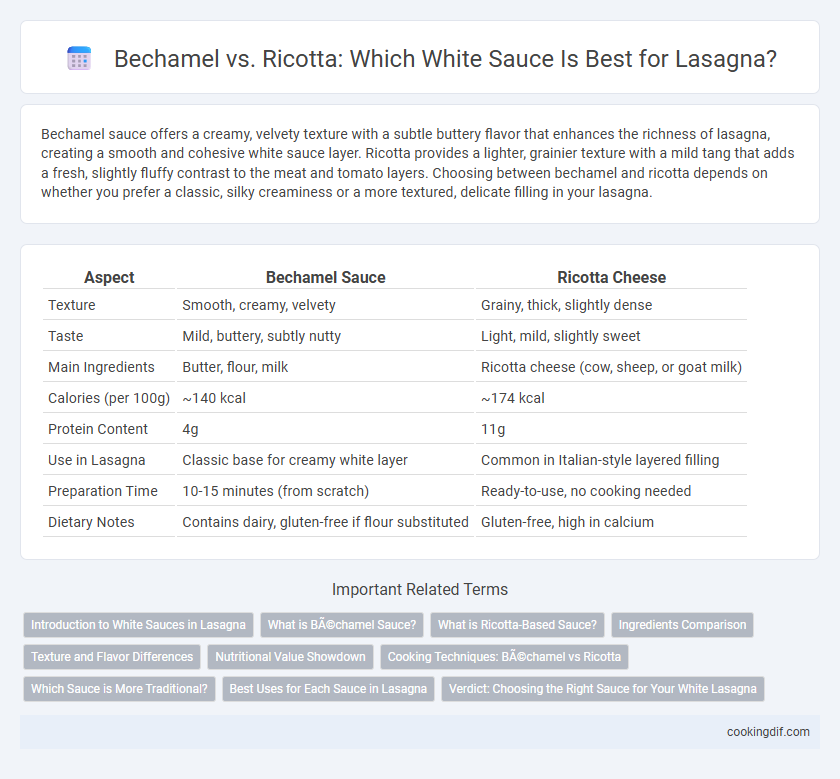Bechamel sauce offers a creamy, velvety texture with a subtle buttery flavor that enhances the richness of lasagna, creating a smooth and cohesive white sauce layer. Ricotta provides a lighter, grainier texture with a mild tang that adds a fresh, slightly fluffy contrast to the meat and tomato layers. Choosing between bechamel and ricotta depends on whether you prefer a classic, silky creaminess or a more textured, delicate filling in your lasagna.
Table of Comparison
| Aspect | Bechamel Sauce | Ricotta Cheese |
|---|---|---|
| Texture | Smooth, creamy, velvety | Grainy, thick, slightly dense |
| Taste | Mild, buttery, subtly nutty | Light, mild, slightly sweet |
| Main Ingredients | Butter, flour, milk | Ricotta cheese (cow, sheep, or goat milk) |
| Calories (per 100g) | ~140 kcal | ~174 kcal |
| Protein Content | 4g | 11g |
| Use in Lasagna | Classic base for creamy white layer | Common in Italian-style layered filling |
| Preparation Time | 10-15 minutes (from scratch) | Ready-to-use, no cooking needed |
| Dietary Notes | Contains dairy, gluten-free if flour substituted | Gluten-free, high in calcium |
Introduction to White Sauces in Lasagna
Bechamel sauce, a classic French white sauce made from butter, flour, and milk, offers a creamy and smooth texture with a subtle richness that enhances lasagna layers. Ricotta, an Italian cheese, provides a thicker, grainier consistency with a mild, slightly sweet flavor that creates a hearty and textured filling. Choosing between bechamel and ricotta impacts the overall mouthfeel and moisture balance in traditional and modern lasagna recipes.
What is Béchamel Sauce?
Bechamel sauce, also known as white sauce, is a classic French sauce made from a roux of butter and flour cooked with milk to create a smooth, creamy texture often used in lasagna for its rich flavor and silky consistency. Unlike ricotta, which is a fresh cheese with a grainy texture and mild taste, bechamel provides a velvety base that enhances the lasagna layers with subtle creaminess without overpowering other ingredients. This sauce serves as a traditional binder in many lasagna recipes, contributing to the dish's signature moistness and cohesive structure.
What is Ricotta-Based Sauce?
Ricotta-based sauce in lasagna is a creamy mixture made primarily from ricotta cheese, often combined with eggs, herbs, and sometimes Parmesan for added richness and texture. Unlike bechamel sauce, which is a smooth, flour-thickened white sauce made from butter, flour, and milk, ricotta-based sauce offers a thicker, grainier consistency that adds a rich, slightly tangy flavor to the layers. This sauce enhances the lasagna with a hearty, cheese-centric profile, making it a popular alternative in Italian-American lasagna recipes.
Ingredients Comparison
Bechamel sauce is traditionally made from butter, flour, and milk, creating a creamy, smooth texture rich in dairy fats. Ricotta, derived from whey cheese, offers a grainier texture with a mild, slightly sweet flavor and higher protein content. Both ingredients provide a white sauce option for lasagna, but bechamel emphasizes a silky consistency while ricotta brings a lighter, cheesier element.
Texture and Flavor Differences
Bechamel sauce offers a creamy, velvety texture with a subtle buttery flavor that enhances the layers of lasagna without overpowering other ingredients. Ricotta provides a grainier, richer consistency with a slightly tangy, milky taste, adding distinct flavor complexity and a thicker mouthfeel. Choosing between bechamel and ricotta impacts the overall lasagna experience by balancing creaminess against texture variation and flavor boldness.
Nutritional Value Showdown
Bechamel sauce, made primarily with butter, flour, and milk, offers a creamy texture rich in calcium and vitamin D but tends to be higher in fat and calories compared to ricotta cheese. Ricotta provides a protein-packed alternative with lower saturated fat and a good source of essential amino acids, making it a healthier choice for those monitoring cholesterol levels. Choosing between bechamel and ricotta impacts the overall nutritional profile of lasagna, influencing calorie count, fat content, and protein intake.
Cooking Techniques: Béchamel vs Ricotta
Bechamel sauce, made from butter, flour, and milk, requires careful whisking and constant heat to achieve a smooth, creamy texture without lumps, ideal for a velvety base in lasagna. Ricotta, often used without cooking or lightly blended with eggs and seasonings, provides a lighter, grainier texture and requires minimal technique beyond simple mixing. Understanding these cooking methods impacts the overall consistency and flavor balance in white sauce lasagna recipes.
Which Sauce is More Traditional?
Bechamel sauce is the more traditional choice for white sauce in classic Italian lasagna recipes, especially in northern Italy, where it adds a creamy and velvety texture with its mixture of butter, flour, and milk. Ricotta, while popular in American and southern Italian lasagna variations, provides a thicker and grainier consistency, contributing to a richer but less smooth layering. Traditional lasagna alla Bolognese typically incorporates bechamel to balance the savory meat ragu and pasta sheets, highlighting its historical authenticity in lasagna preparation.
Best Uses for Each Sauce in Lasagna
Bechamel sauce, with its creamy texture and subtle buttery flavor, is ideal for classic Italian lasagna recipes that emphasize a smooth, velvety consistency between the layers. Ricotta cheese, thicker and tangier, works best in hearty vegetable or meat lasagnas where its rich texture adds body and contrasts with robust fillings. Choosing Bechamel enhances delicate lasagna varieties like white sauces or seafood, while Ricotta complements rustic, traditional lasagnas featuring robust tomato sauces and savory meats.
Verdict: Choosing the Right Sauce for Your White Lasagna
Bechamel sauce offers a creamy, velvety texture with a subtle buttery flavor that perfectly complements traditional lasagna layers, making it ideal for classic white lasagnas. Ricotta provides a richer, grainier consistency packed with a mild tang, adding extra moisture and depth suitable for a heartier, rustic white lasagna. Selecting between bechamel and ricotta depends on whether you prefer a smooth, delicate sauce or a more textured, flavorful filling to define your white lasagna experience.
Béchamel vs Ricotta for white sauce Infographic

 cookingdif.com
cookingdif.com